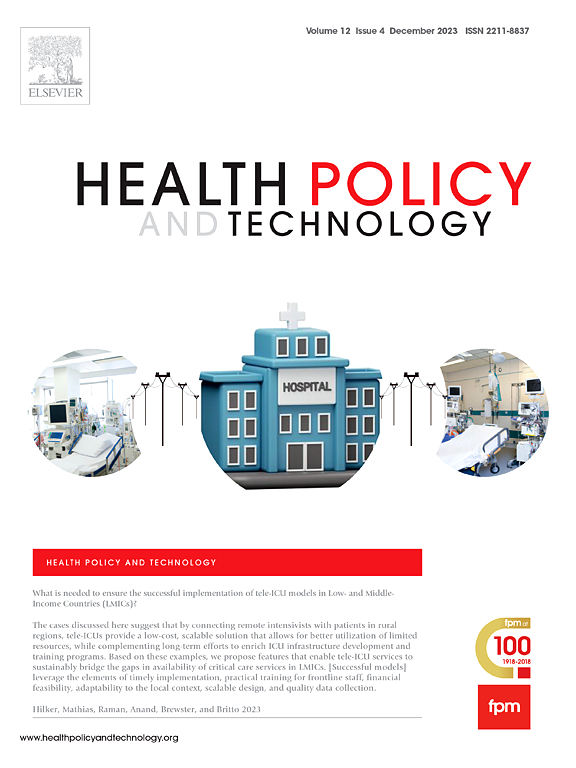在大流行病期间采用联系人追踪应用程序:用户的抵制行为
IF 3.7
3区 医学
Q1 HEALTH POLICY & SERVICES
引用次数: 0
摘要
本研究调查了影响用户采用为追踪 COVID-19 感染而推出的接触追踪智能手机应用程序的不同障碍的关键问题。研究分两个阶段考察了印度用户对用于预防 COVID-19 传播的 Aarogya Setu 应用程序的体验。在第一阶段,我们使用开放式和轴向编码对 Google Play 商店中的在线用户评论进行了定性分析。然后,利用这些编码创建了影响矩阵和分层价值图,以说明和解释问题、障碍和用户行为之间的关系。第二阶段是补充性实证研究,通过半结构化电话访谈从应用程序的用户和非用户那里收集数据,然后进行定性分析。通过借鉴创新阻力理论,本研究将一系列采用障碍与三种类型的用户阻力(即推迟、反对和拒绝)进行了映射。拒绝是最突出的消费者抵制行为;与应用程序使用相关的使用障碍、功能风险和价值障碍是这一行为的主要驱动因素。推迟是第二大消费者抵制行为。如果说应用程序的使用障碍、功能风险和价值障碍导致了采用应用程序的功能障碍,那么形象障碍则是心理障碍背后的关键原因。未来干预措施的管理者和开发者需要通过利益相关者的参与,意识到与应用程序使用相关的使用障碍、功能风险和价值障碍,以确保更广泛、更快速地采用此类应用程序来改善医疗信息系统。本文章由计算机程序翻译,如有差异,请以英文原文为准。
Adoption of contact tracing app during pandemic: Users’ resistance behavior
Objectives
The study investigates the key issues influencing different barriers resulting in user resistance toward adopting contact tracing smartphone apps launched to track COVID-19 infections.
Methods
Indian users’ experiences regarding the Aarogya Setu app for preventing the spread of COVID-19 were examined in two phases. In Phase I, online users’ comments available at the Google Play Store were qualitatively analyzed using open and axial coding. These codes were then used to create an implication matrix and hierarchical value maps to illustrate and interpret the relationships between issues, barriers, and user behavior. In Phase II, a supplementary empirical study, data was collected from users and non-users of the app through semi-structured telephone interviews and then qualitatively analyzed.
Results
By drawing on innovation resistance theory, the current study mapped a set of adoption barriers with three types of user resistance, i.e., postponement, opposition, and rejection. Rejection emerged as the most prominent consumer resistance behavior; usage barriers, functional risk, and value barriers related to the app's usage were the key drivers of this behavior. Postponement was the second most observed consumer resistance behavior. If usage barriers, functional risk, and value barriers of the app resulted in functional barriers toward adoption of the app, then image barrier was the key reason behind the psychological barrier.
Conclusion
Administrators and developers of future interventions need to be conscious of usage barriers, functional risks, and value barriers related to the app's usage through stakeholder engagement to secure broader and faster adoption of such apps to improve health information systems.
求助全文
通过发布文献求助,成功后即可免费获取论文全文。
去求助
来源期刊

Health Policy and Technology
Medicine-Health Policy
CiteScore
9.20
自引率
3.30%
发文量
78
审稿时长
88 days
期刊介绍:
Health Policy and Technology (HPT), is the official journal of the Fellowship of Postgraduate Medicine (FPM), a cross-disciplinary journal, which focuses on past, present and future health policy and the role of technology in clinical and non-clinical national and international health environments.
HPT provides a further excellent way for the FPM to continue to make important national and international contributions to development of policy and practice within medicine and related disciplines. The aim of HPT is to publish relevant, timely and accessible articles and commentaries to support policy-makers, health professionals, health technology providers, patient groups and academia interested in health policy and technology.
Topics covered by HPT will include:
- Health technology, including drug discovery, diagnostics, medicines, devices, therapeutic delivery and eHealth systems
- Cross-national comparisons on health policy using evidence-based approaches
- National studies on health policy to determine the outcomes of technology-driven initiatives
- Cross-border eHealth including health tourism
- The digital divide in mobility, access and affordability of healthcare
- Health technology assessment (HTA) methods and tools for evaluating the effectiveness of clinical and non-clinical health technologies
- Health and eHealth indicators and benchmarks (measure/metrics) for understanding the adoption and diffusion of health technologies
- Health and eHealth models and frameworks to support policy-makers and other stakeholders in decision-making
- Stakeholder engagement with health technologies (clinical and patient/citizen buy-in)
- Regulation and health economics
 求助内容:
求助内容: 应助结果提醒方式:
应助结果提醒方式:


